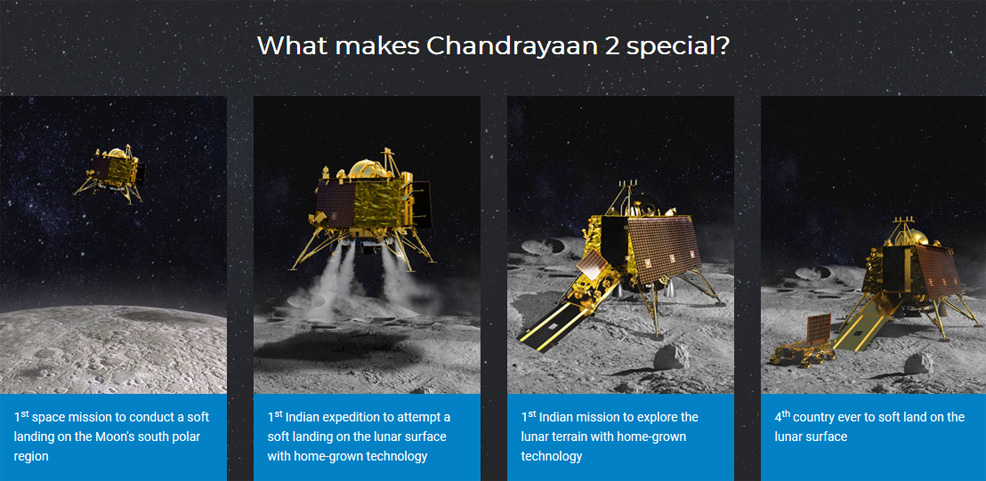
22nd July 2019 Indian Moon mission blasts off The Indian Space Research Organisation (ISRO) has today launched Chandrayaan-2, its second lunar exploration mission, which includes an orbiter, lander and rover.
Chandrayaan-2 blasted off atop a GSLV Mk-III – the most powerful rocket developed by ISRO – at 14:43 IST (09:13 GMT), from Satish Dhawan Space Centre in southeastern India. This follows an aborted first attempt, originally scheduled for 14th July, but delayed due to a technical glitch. The rocket performed better than expected, achieving a 15% increase in performance and saving 6,000 km (3,700 miles) worth of fuel, which allows more flexibility with further manoeuvres. The spacecraft is currently in Earth orbit, where it will stay for 23 days before a series of manoeuvres transfer it to lunar orbit. The main scientific objective is to map the location and abundance of water, a resource vital to any future colony. The orbiter will fly around the Moon at 100 km (62 mi) altitude carrying five scientific instruments, including a high-resolution camera to observe the landing site. The lander (called Vikram) will detach from the orbiter and descend to a high plain between two large craters, Manzinus C and Simpelius N. A wheeled rover will then deploy from Vikram, moving across the lunar surface and performing on-site chemical analysis, relaying data back to Earth via the orbiter. If successful, this will make India only the fourth country to achieve a soft landing on the Moon, after the former USSR, USA and China. It will also become the first mission to soft land near the lunar south pole. The 27 kg (60 lb) rover will operate on solar power and travel approximately 500 metres (1,640 ft), moving at 1 cm (0.4") per second. The expected lifetime is one lunar day or around 14 Earth days, but its power system has a solar-powered sleep/wake-up cycle implemented, which could result in a longer service time than planned. Stereoscopic camera vision in front of the rover will provide the ground control team a 3D view of the surrounding terrain and help in path-planning by generating a digital elevation model. "Today is a historical day for space, science and technology in India," said ISRO Chairman, Dr. K Sivan. "I am extremely happy to announce that GSLV MkIII-M1 successfully injected Chandrayaan-2 into an orbit of 6,000 km more than the intended orbit. Today is the beginning of the historical journey of India towards the Moon and to land at a place near the south pole to carry out scientific experiments to explore the unexplored." Chandrayaan-2 follows the earlier Chandrayaan-1, which launched in October 2008 and operated until August 2009, studying the Moon from orbit. India is planning a third mission, Chandrayaan-3, for launch in 2024. If approved and funded, this will demonstrate new surface exploration technologies related to vehicular transport and lunar night survival, for sustainable exploration in polar regions. Water prospecting, sample collection and analysis are likely to be among the mission objectives.
Comments »
If you enjoyed this article, please consider sharing it:
|







